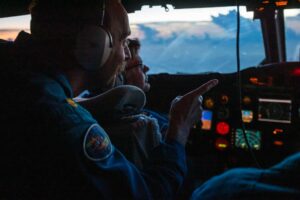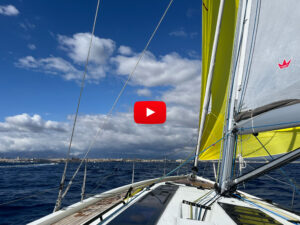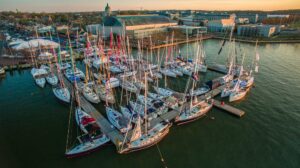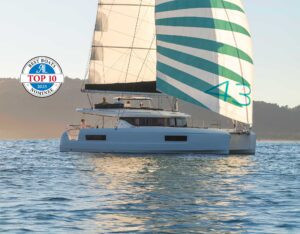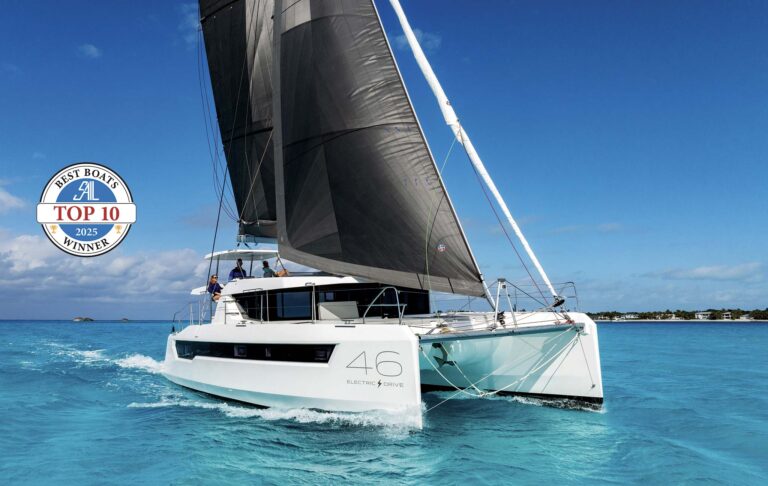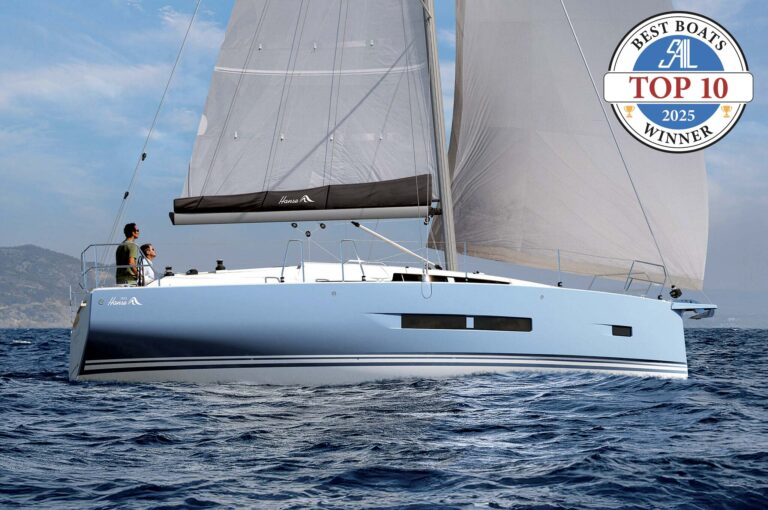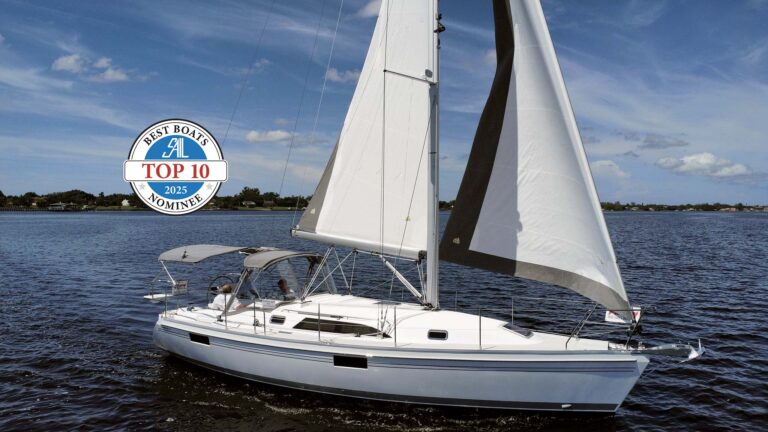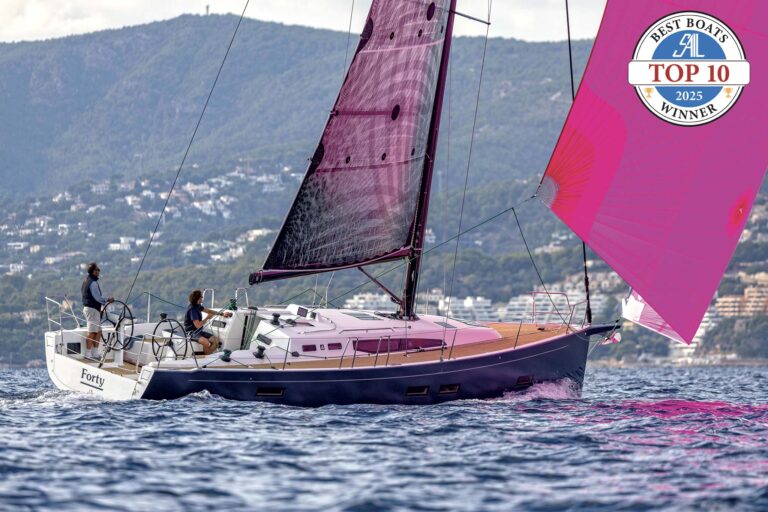Not only is Bavaria Yachtbau one of the world’s largest boatbuilders, it has got to be one of the hardest working. When it came time to begin work on what would become its new Vision line, the company didn’t just sit around and brainstorm what it thought its customers would like. Instead it went out and spoke to the customers themselves—hundreds of them—to find out what they thought worked (and didn’t work) on a cruising boat.
The initial result of all this effort was the handsome, comfortable Bavaria Vision 46. Now that same “vision,” so to speak, is available in a 42-foot version, also from the Farr design office.
Construction
Bavaria’s hulls are an e-glass/Divinicell foam core sandwich above the waterline and solid glass below, all hand-laid. A fiberglass grid is both bonded to the inside of the hull and secured by the keel bolts to provide rigidity and help support the rig loads. The deck and cabinhouse are also cored and attached to the hull on an inward-turning flange.
The double-spreader Seldén mast is deck-stepped and comes standard with in-mast furling in the United States. Two different keels are available: a deep-draft fin drawing 6ft 9in, and a shallower fin drawing 5ft 4in for thin-water cruising.
Teak trim comes standard in the cockpit and on the helm seats, and is an option for the boat’s side decks. Twin helms and a Seldén headsail furler also come standard. Overall construction quality is excellent, thanks in no small part to Bavaria’s well-thought-out and highly repeatable build process.
On Deck
With its long, curvaceous cabintrunk, the Vision 42 offers the same dramatic styling pioneered by the V46. I especially like the way the trunk transitions directly into the cockpit coaming, creating not only an attractive continuous line, but a secure bulwark against the elements.
Aft, the boat’s twin helms lead to an extremely large drop-down swimstep—a Bavaria trademark. The helms themselves are well-laid-out and practical, with cutouts in the sidedecks seats that make it comfortable to sit to windward while playing the shifts, my favorite steering position. Each helm station comes equipped with a couple of oblong backrests attached to the stern pulpit. Although I found them a little strange looking at first, they sure are comfortable to lean against, and I’m now a believer.
The side decks are wide and securely bordered by solid double lifelines and a teak toerail for security. The molded-in nonskid is good, chainplates are set outboard, and there are a pair of refreshingly solid stainless steel handrails on either side of the cabintrunk. The tracks for the blade jib are recessed into the top of the house, and flush-deck hatches are used throughout.
The companionway is flanked by another pair of sturdy handrails, and there is a small bridgedeck to keep out any errant water in a seaway. Aft of that is a grate-covered rope bin set in the sole.
For the luxury seekers among the crew, the cockpit table is one of those ingenious folding affairs that serves not only as a dining space for a crowd, but can also be lowered to form a generous double berth for sleeping under the stars. For the engineering nerds aboard, the mechanism that makes this possible is nothing less than ingenious.
There is no mainsheet traveler— instead there is a double mainsheet tackle running to blocks on either side of the cabintop. This takes some getting used to, as the two have to be coordinated when going from one tack to the other. However, this same system allows you to put the boom just where you want it once you’re on course, and it also offers a measure of safety in the event of an uncontrolled gybe.
Accommodations
The Vision 42 is available with either two or three cabins and one or two heads. Our test boat’s two-cabin/single head layout is certainly the way to go, as it yields an expansive owner’s cabin forward (no ensuite head and shower taking up a lot of space) and an enormous storage area aft where the starboard sleeping cabin would otherwise be.
The port cabin is especially comfortable, because the companionway is offset slightly to starboard, thus providing it with some additional volume. Not only is it a spacious double, it can be easily divided up into a pair of generous single berths.
There’s nothing particularly exceptional about the layout of the saloon, other than the fact that it is well executed and very comfortable. The dinette table is as ingeniously conceived as its counterpart out in the cockpit, and can be lowered to create yet another double berth to starboard. There is a small counter inboard of the L-shaped galley to help you stay on your feet when cooking in rough conditions, and the nav table slides down to create a short settee to port. Not only is engine access excellent, but the various openings have been deliberately positioned so that the various filters, strainers, etc. you have to deal with most are close at hand. The list of well-conceived features goes on and on.
Oh, and the finish is excellent throughout.
Under Sail
It would be hard to imagine a better day for a sail on Long Island Sound than what we had for testing the Vision 42—a steady breeze in the upper teens and almost-flat water.
Hardened up to a 40 degree true wind angle, the boat powered along confidently at 6 knots in 16 knots true wind with just enough pressure on the helm to let you know what was going on with the foils. Never once did the boat feel like it was in any danger of rounding up, even when I sailed her a little bit fatter in the puffs just to see what would happen. Although it was possible to pinch up to 30 and even 35 degrees apparent, the speed dropped off a knot or two.
Cracking off onto a beam reach, we easily topped 7 knots in the heavier stuff, and maintained a good 5.75 knots as the true wind dropped down below 12 knots. Although the mainsheet winch was within easy reach of the helm, I confess I never quite got the hang of coordinating the control lines, during gybes in particular. That said, I really like the way the mainsheet arrangement allows you to fine-tune the mainsail shape with the help of the vang.
Under Power
Although the Vision 42 is available with Bavaria’s proprietary “Dock Control” system, which includes both bow and stern thrusters, the boat is plenty easy to maneuver using the optional bow thruster alone. Despite the fairly high topsides, we still managed to extricate ourselves from an extremely tight slip in a stiff crosswind with no problem. Powering into that same stiff breeze, we logged 4.5 knots at rpm and 5.7 knots revving the auxiliary and three-blade fixed prop to 2,000 rpm.

